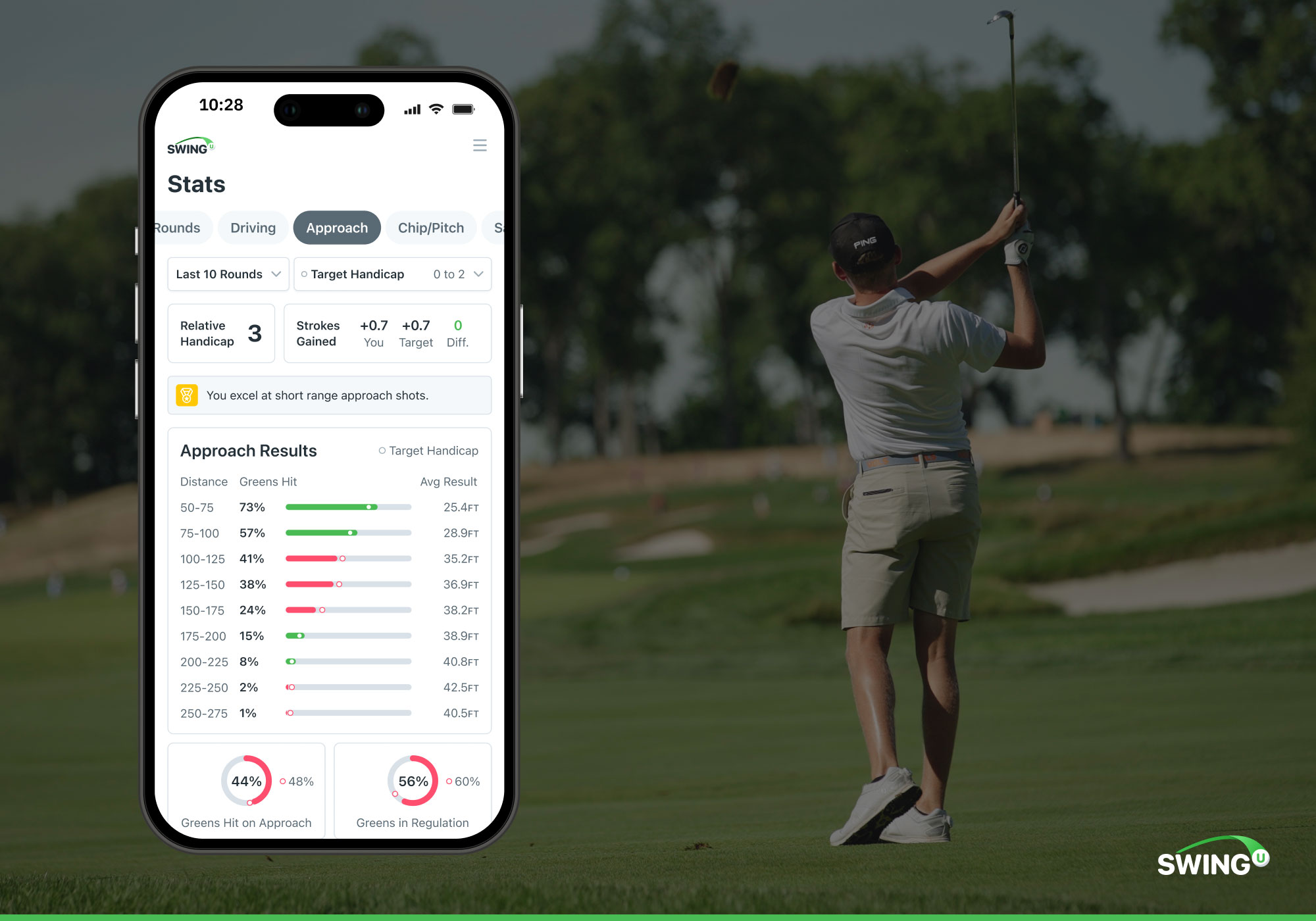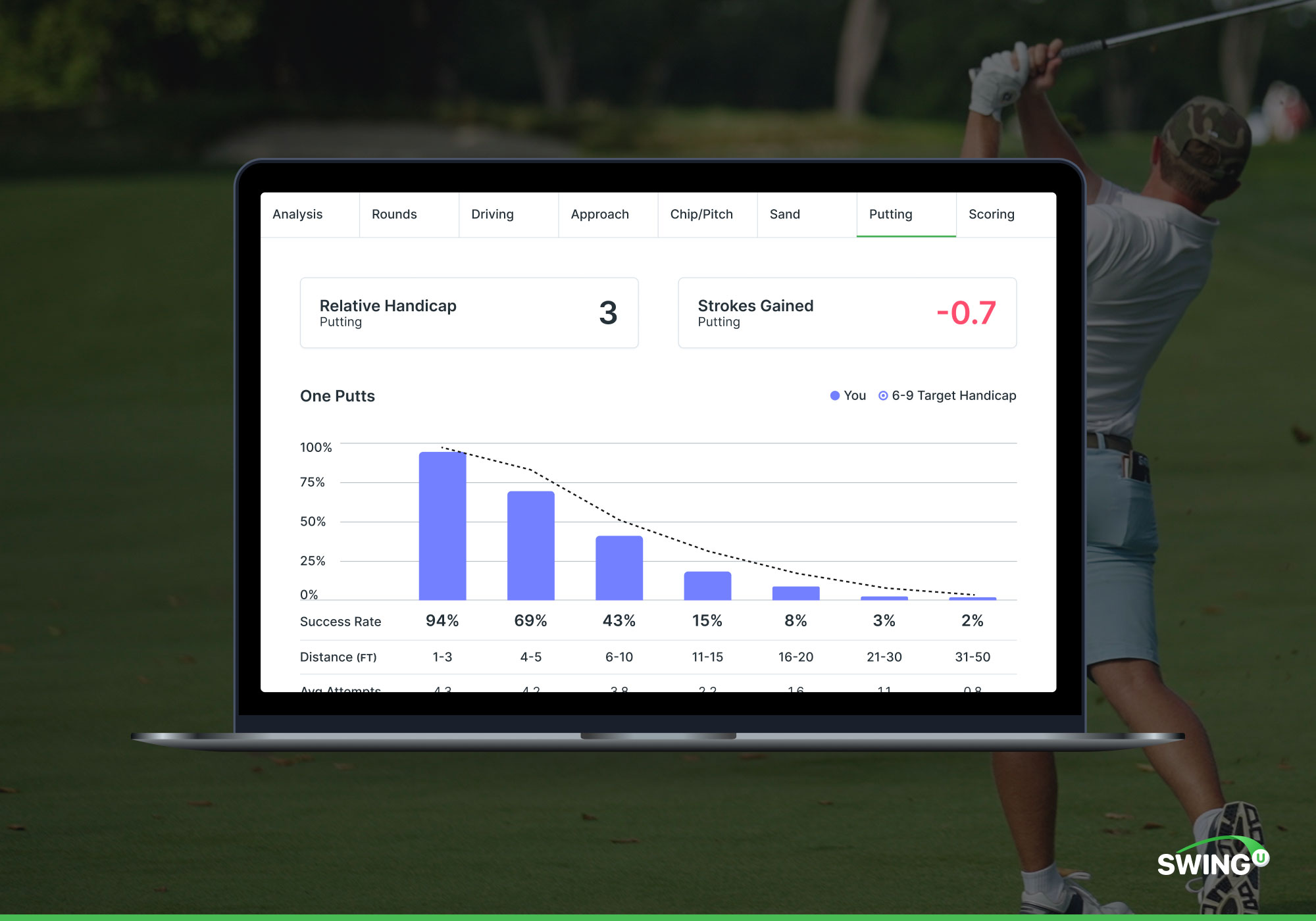The following is an excerpt from Jon Sherman’s The Four Foundations of Golf, a complete guide to golf that a player of any level can use to lower their scores and increase their enjoyment of the game.
This excerpt comes from Part Two of Jon’s Book: PRACTICE.
Golfers can get caught up in a cycle of spending time at the practice facility with no plan and working on the wrong parts of their game. I’d like to give you some ideas on spending your time more productively with the guidance of statistics.
Efficiency With Limited Time
With limited time, recreational golfers need to be efficient and work smart when they have the opportunity to practice. Since no one explains the hows and whys of what that looks like, many mistakes are pretty common.
For starters, there is usually no overall plan. I would show up to the driving range for years and haphazardly hit balls. I know I was not alone. The other range stalls were filled with other clueless hackers.
Another big mistake is that golfers spend time on parts of the game that will yield little or no results. There are a few reasons why this occurs:
- We’ll continue to hone a mostly developed skill by gravitating towards what comes easily, and further gains are likely minimal.
- Spending time on shots that we don’t encounter all that much on the course.
- General misconceptions about which parts of golf will most impact scoring. For example, investing 50% of your practice time on five-foot putts will not improve your handicap dramatically.
Meanwhile, other more important elements are ignored. Your time is a precious resource that needs to be invested wisely. You want to look for opportunities that can achieve significant returns.
How Statistics Can Help
I spoke a lot about statistics in the strategy and managing expectations section, extolling how strokes gained analysis clarifies performance. Understanding how scoring occurs in golf and then using your statistics as a guide can help you spend more productive time at the range.
To be clear, I’m not talking about traditional statistics. Tracking how many fairways you hit each round or total putts is not enough information. At best, they can give you a few clues on where you need to spend your time. However, for many, they can be misleading.
A myriad of apps and shot-tracking systems are available now to make this process more streamlined for those who are more analytical and willing to put a little more effort into their games.
Whatever system you use, the advantage will be receiving a clear, top-level explanation of your golf game’s relative strengths and weaknesses. For example, if you are a 15-handicap, many apps will compare your performance to other handicap benchmarks.

An example of comparing performance versus different handicap benchmarks using strokes gained. Negative values indicate areas that need improvement, and positive values indicate areas of relative strength.
You will see where you are gaining and losing strokes on tee shots, approach shots, wedge play, and putting.
Usually, seeing top-level strokes gained data is an eye-opener. It could reveal that areas of the game where you are spending most of your practice time are already a strength, and there isn’t much “juice left to squeeze.” Conversely, there could be easier opportunities where targeted practice yields quick wins.
View this post on Instagram
Strokes gained statistics are a great starting point, but you will have to do a little more detective work. I’ll provide some examples of how that can look in each part of the game.
Driving
Your performance off the tee is a combination of how far you can hit the ball while keeping it in play and avoiding big trouble.
We primarily relied on fairways hit as a measuring stick in the past. But that number can be misleading. You could average 75%, which would mean you are a great performer off the tee on the surface. However, let’s say you were only averaging 200 yards with your tee shots; you could be losing strokes off the tee versus a player who hit it farther but only averaged 55% of their fairways.
Taking a stat like fairways hit in conjunction with strokes gained performance is a better starting point. Additionally, with most systems, you can dive deeper into your shot distributions and see a visual representation of your tendencies off the tee.
If you found yourself losing strokes off the tee versus a handicap level you are looking to achieve, I would suggest finding the answers to the following questions:
- Is this a distance issue? If you find yourself comparable in avoiding big trouble (penalties, trees, fairway bunkers) and fairway accuracy, then adding distance is likely the only way to gain strokes. Perhaps it’s because you are not using your driver enough or need to learn how to hit your driver farther.
- Are big mistakes costing you strokes? Are you finding yourself in recovery situations and penalty areas?
- Is your dispersion reasonable? Most shot-tracking systems will show you a visual representation of your tee-shot distribution. It is possible that you aren’t hitting enough fairways to keep up.
Alternatively, if you are not using a stat-tracking system, you could use my definition of a successful drive as a better measuring stick. You could track the following three scenarios in each round:
- Fairways hit
- Successful tee shots: you advanced the ball close to your average distance, have a clear path to the green, and a reasonable lie (think light rough).
- “Oops Swings” – whenever your ball ends up in a recovery situation, penalty area, or out of bounds.
If you increase the amount of successful tee shots, and decrease the “oops swings” then you know you are on the right path.
Approach Shots
Typically, approach play is the most critical part of golf in how golfers separate themselves from one another in scoring. I still believe that Greens In Regulation (GIR) is a fundamental statistic, and golfers should build their game (through practice and strategy) around hitting more greens. GIR has the highest correlation with scoring and handicap level than any other stat.
However, approach play primarily comes down to proximity to the hole, which GIR cannot measure. Additionally, when you are missing greens, where you end up plays a significant factor in scoring potential. For example, if you miss a green in a bunker and are short-sided, that shot will lose more strokes than where you had a short chip and plenty of green to work with.
If you want the most precision, using a combination of GIR, strokes gained, and analyzing where your approach shots end up will give you a very clear picture of what you need to work on.
View this post on Instagram
Here are some questions that I find are helpful to answer:
- Examine your misses from a distance perspective (short and long). The majority of golfers miss in front of the green rather than behind. Some of these are strategic mistakes. Other times it can be an inability to strike clubs on the center of the face. Impact training is a great way to work on these issues.
- Analyze your lateral misses. Do you see a pattern towards left or righthand bias? Are you short-siding yourself relative to pins quite often? Again, these could be strategic mistakes. But usually, it’s controlling where the clubface is pointing at impact and managing the club’s path through the impact zone.
- Is ground contact an issue? Controlling the low point of the golf club is very important in approach play. Think back to shots where you are missing the green, and try to evaluate if you are getting the ball first and then turf contact.
Wedge Play
Some apps define wedge play as inside 100 yards, while others use inside 50 yards as their benchmark. Either way, proximity to the hole is the measuring stick to determine whether you are outperforming or underperforming from these distances.
Distance control becomes more critical as you get closer to the hole, and lateral (left to right) dispersion is usually not as big of an issue. I find strokes gained particularly helpful with wedge play because they reveal certain distances where you are having problems. For example, you might find out that you are a great wedge player from 60-100 yards but struggle as you get closer to the greens.
View this post on Instagram
If you find yourself deficient in one or several distance categories, I find that wedge play is where golfers can quickly pick some low-hanging fruit. So many golfers don’t practice their wedges at all, and if you refer to the chapter on wedge practice, I think you’ll get some great ideas.
Putting
Putts per round is another traditional statistic that can be very misleading. I could provide plenty of scenarios where someone with 30 putts over 18 holes could outperform or underperform golfers at the same skill level. It’s just not enough information. Strokes gained is far more prescriptive in explaining your putting performance and what distances you need the most work.
You will need to do more work to track your strokes gained by putting statistics effectively. Some automatic GPS shot-tracking systems will identify when you made contact with the ball, and you can tag where the pin was on each hole. Sometimes, GPS is not precise enough (yet) to tell whether you had a 6-foot putt or an 11-foot putt.
Those who take detailed statistics of their putting walk off the distance of each putt and note them on their scorecard after each hole. How far you are from the hole on each putt will allow strokes gained to assign a value to each stroke. While it might be a little more tedious, it will give you much more valuable information on where you need to practice more.
Like wedge play, you will receive your strokes gained performance based on proximity to the hole. You also usually can see your make rates by distance, three putting, and how many putts miss short or long of the hole.

The three primary putting skills are speed control, face control, and green reading ability.
If you were losing strokes from the 0-10 feet range, I would suggest that face control (your ability to start the ball on your intended line) is likely your biggest issue. Those are the distances where you have an excellent chance of making putts, and as you miss more and more of them, your strokes gained will dive deeper into negative territory.
Speed control becomes more paramount as you get further away from the hole.
As you get outside of 10 feet, and your chances of making putts decrease dramatically, putting becomes a game of proximity. If you are losing strokes from further distances, it’s because you are leaving yourself outside a reasonable range from the hole, not because you didn’t make the putt. Speed control becomes more crucial, and your ability to reasonably determine the break of the putt. Working on those skills will likely save you strokes and eliminate the common culprit – three-putting.
Overall, going through a detailed analysis of your statistics is one of the most efficient ways to plan your practice sessions. There will be plenty of opportunities for many to create quick wins in parts of the game you are deficient. But you need to know where to look!
The Big Ideas
- With limited time, golfers need to be efficient with their practice methods.
- Using advanced statistics can help identify deficiencies in your game. Spending some time on your weaknesses rather than your strengths can lead to quick wins.
- Many stat tracking apps can do advanced strokes gained calculation, giving golfers tour-level analysis of their games. Taking a deeper dive into each part of your game can unlock important clues to guide your practice sessions.





